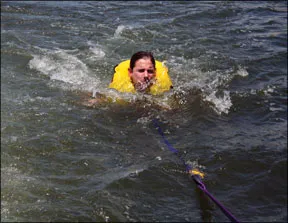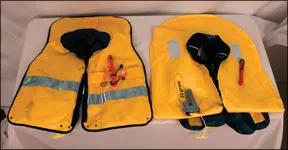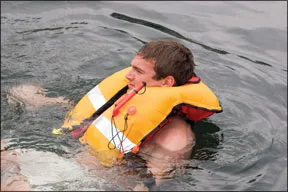
288
It’s no wonder the combination personal flotation device (PFD) and safety harness have caught on among offshore racers and cruisers alike: It’s easier and faster to don an all-in-one harness-PFD than it is to put on a harness and then a life jacket—and if a situation calls for one or the other, it’s a good bet you should wear both.
While inflatable PFD-harness combos can offer a more comfortable alternative to traditional life jackets, they must be properly inspected and maintained regularly in order to work. Fired by small CO2 cartridges, the inflation mechanisms on these devices have improved over the years, but they still require vigilance.
In the past, criticisms of inflatable PFD-harnesses traditionally have been discomfort at the neck, high prices, and unreliable inflation. The newer designs are more comfortable, and their reliability has improved. The U.S. Coast Guard recently changed the designation of some inflatable PFD models from Type V to Type III, meaning they don’t have to be worn in order to meet the Coast Guard’s one-PFD-per-person requirement for recreational boats.
Best suited for inshore waters, Type III inflatable PFDs must have a minimum buoyancy of 22.5 pounds. They must be readily accessible in an emergency, have a full CO2 cylinder, and all status indicators must show the vests are serviceable. The Type V classification refers to “special purpose” PFDs—those designed for specific uses—which must have 22.5 to 34 pounds of buoyancy. Inflatable PFDs classed as Type Vs must be worn at all times in order to satisfy the USCG carriage rule for safety equipment aboard a recreational boat.
Although the Coast Guard has no set standard for safety harnesses, offshore racing regulatory committees require crew to have them. The International Sailing Federation (ISAF) this year updated its Offshore Special Regulations (OSR) regarding PFDs. They must have a whistle, reflective tape, SOLAS-approved light, a compressed-gas inflation system, and thigh/crotch starps in order to satisfy the ISAF race rules. ISAF recommends PFDs be equipped with sprayhoods and personal locator beacons (PLBs).
US Sailing—the national governing body of sailing in the US—requires that PFDs have many of the same features that ISAF requires, but not crotch/thigh straps, which US Sailing only recommends.
Only one PFD reviewed here meets the ISAF OSR rules, the Spinlock Deckvest. None of the others offer crotch straps. One manufacturer, Revere Survival Products, explained that adding crotch straps to its inflatable PFDs would invalidate their U.S. Coast Guard approval status. The Spinlock is not USCG approved.
In the June 2008 issue, Practical Sailor looked at 10 of the newest inflatable PFDs without harnesses. In that test, the Revere ComfortMax model numbers 61018 and 61019 rated as favorites.
What Was Tested
Since Practical Sailor’s last review of inflatable PFD-harness combos in December 2006, several new products have hit the market. In that previous test, the auto-inflatable Mustang 3184 took top honors, while the Stearns Ultra got the nod for the best manually inflated combo. For this article, Practical Sailor looked at eight more inflatable PFDs with integral harnesses. Some are new, and some have been around for a while, but never reviewed. These include the unique Spinlock Deckvest often seen on the backs of offshore racers. Six of the PFD-harnesses in this review offer both manual and automatic inflation. The manual units inflate when the user pulls a tab connected to the CO2 inflator. The automatic units inflate when the inflation mechanism is immersed in water. None of the PFDs in this test use the pressure-sensitive Hammar inflator (found in the Mustang 3184), which inflates when the jacket is immersed 10 centimeters below the water’s surface. All the vests also have an oral inflation tube.
From Bluestorm, we tested the Pro Sail 33, X-Treme Sail 33, and Sport Sail 33. We also evaluated the Helly Hansen HI250, Protexion’s Nautilus Deluxe, and two from the Revere ComfortMax series.
All of the test vests use 33-gram CO2 cylinders. Except for the Spinlock (which doesn’t specify), the PFDs have a minimum user age of 16 years old and minimum user height of 5 feet, 5 inches. Seven of them call for a minimum user weight of 80 pounds, while the Spinlock’s minimum is 110 pounds.

288
Also, all five of the PFDs in this test that are USCG certified are classed as Type Vs. The Helly Hansen, Protexion, and Spinlock are not USCG approved. USCG certification is a reassuring stamp of approval and can save you the hassle of carrying additional PFDs on board to meet the minimum requirements. However, previous Practical Sailor tests have found that some excellent PFDs are marketed primarily in Europe and Canada and so are designed to meet those slightly different, but no less stringent, standards.
Bluestorm
Marine Technologies International, marketer of the Bluestorm PFD brand, is headquartered in Plympton, Mass. The safety and marine apparel maker started the Bluestorm label in 2006; manufacturing facilities are in Shanghai, China. We tested the Bluestorm Pro Sail 33 (S6F), X-Treme Sail 33 (S1F), and Sport Sail 33 (S3F). One of the main differences between the three is the type of Halkey Roberts inflation mechanism. The Sport Sail uses the manually operated 3F. The Extreme Sail uses the 1F model, which includes a bayonet fitting for the C02 cylinder to indicate when the cylinder is positively engaged with the automatic firing mechanism. Unfortunately, the 11-step re-arming instructions for the 1F are not to be found on the X-Treme Sail 33—a common problem on jackets with this type of inflator. The Pro-Sail 33 uses the slightly less bulky 6F inflator with screw-on CO2 cylinder, which is easier to re-arm.
It is important to note that although the 1F bayonet fitting makes it more obvious when the CO2 cylinder is not fully connected with the inflation mechanism, Halkey-Roberts has issued a warning that the service indicator can still show proper arming when it is not. Whatever inflator you use, carefully follow the re-arming instructions, which should printed on the PFD or its tag.
The Bluestorm jackets all feature a whistle and 16 square inches of reflective material on the air bladders. They were the only test products to use Velcro and plastic snaps to secure the cover around the uninflated bladder. Testers have found that after extended use, the Velcro on some PFD covers begins to fail, leaving wearers to be flogged by their life jacket in a breeze. The Bluestorm snaps would alleviate this problem.
Testers particularly liked the X-treme Sail and Sport Sail’s clear plastic inspection windows in front of the inflator to make checking its service status easy. This feature is key as inflatable PFDs require regular inspection and servicing. (The Bluestorm Pro Sail and the Spinlock Deckvest were the only PFDs tested that lacked the inspection window.)
All the Bluestorms also have a small zippered pocket on the lower left front to store small items or spare re-arm kits. The Xtreme Sail also has a small interior Velcro pocket.
The harness on all three Bluestorm vests is the same. It is constructed of 2-inch nylon webbing, and the waistband closes with a large, plastic clip. Two stainless-steel D-rings offer easy tether attachment, but they cannot be tucked out of the way. The harnesses can only be adjusted from the right-hand side via a metal slide, but testers found them all easy to don and adjust.
The Bluestorm bladders are attached to the PFD cover/harnesses at three points. Some testers noted that this arrangement felt less secure than those PFDs with a bladder fully attached to the cover harness (like the Revere models).
For on-land comfort/fit, the Bluestorm vests were rated Fair. Testers found them to be snug around the neck despite their padding.
Re-arming/repacking the Bluestorm trio was acceptable. The X-treme Sail was rated lower in this area because it lacks instructions on re-arming. The vests each carry a three-year warranty.
Bottom Line: Overall, all of the Bluestorms garnered decent ratings, have long warranties, and are reasonably priced.
Helly Hansen
Helly Hansen, well known for its work safety and sports apparel, markets several PFD models, including a pair of inflatables. We reviewed Helly’s HI250.
The HI250 uses a Halkey-Roberts 1F automatic inflator (no re-arming instructions on the jacket) to provide just less than 34 pounds of buoyancy. It has a clear-plastic inspection window in front of the inflation mechanism—a plus. It carries a whistle, but has no reflective material on the bladder or PFD cover—a negative.

288
The HI250 uses heavy, 2-inch nylon for the waistband and back straps. A plastic buckle secures the waistband, which can be tightened only from the right side with a Makefast metal adjuster. One-handed adjustment, when it is successfully executed as it is on the HI250, is a big plus. Testers like the setup and rated the HI250 Good for donning.
Small Velcro tabs on the PFD front allow users to tuck the D-rings for the safety tether out the way when they’re not in use.
The HI250, the lightest of the bunch, fit testers well and was rated Excellent for on-land comfort.
The bladder is affixed to the cover at the bottom and at the inside seam. Testers preferred this setup to the point attachment of the Bluestorm bladders, but it still had a tendency to rise up at the neck.
For repacking, the bladder easily folds into position, and loose-patterned Velcro around the outer jacket secures it in place. We rated it Fair in this area as it lacked instruction for re-arming.
Bottom Line: Great on-land fit is offset by a fair in-water fit. We like some of the HI250’s features, but a lack of reflective material and instructions for re-arming keep this one out of the winners’ circle.
Protexion
Helly Hansen Canada purchased Protexion product assets, including the Nautilus line of gear, about two years ago. We tested the top-of-the-line Nautilus Deluxe NIV 2500 inflatable PFD-harness.
This vest uses a Halkey Roberts 1F automatic inflator (no re-arming instructions on the jacket) and has an inflator inspection window, a whistle, 27 square inches of reflective material on the bladder, and reflective detailing on the cover.
Protexion uses heavy, 2-inch nylon for the waistband and back straps. The back strap has some additional padding and webbing sewn in, and a large, plastic buckle secures the waistband. It can be tightened on the right side only with a Makefast metal adjuster. Testers liked the setup and rated the Nautilus Deluxe Excellent for donning.
A pair of stainless steel D-rings can be stored out of the way in a dedicated pocket. A metal snap secures the pocket and keeps the D-rings out of sight. During the course of testing, the metal snap on the test vest developed corrosion and became increasingly difficult to get open and closed. Practical Sailor would like to see this replaced with a fastener that won’t corrode.
The PFD cover is held closed with Velcro, and the air bladder is attached to it along a portion of the vest’s inside seam only. This allowed the bladder to rise and roll inward, squeezing testers’ face and neck. Testers rated it Poor for in-water fit.
Changing out the bobbin in the inflator and swapping the used CO2 cylinder for a new one rearms the Protexion NIV 2500, but there are no instructions outlining the steps.
Bottom Line: Great on-land fit is offset by a poor in-water fit, and the metal snaps were a drawback.
Revere
Florida-based Revere Survival Products, in business for over 70 years, manufactures and imports a variety of survival gear. We tested two harness-equipped versions of the company’s ComfortMax series of inflatable PFDs with harnesses, one with a Halkey Roberts 3F manual inflator and one with the 1F automatic-manual inflator. Both inflators provide 35 pounds of flotation.
Testers found that both PFDs fit very comfortably on land. Wide straps give the wearer a secure feel. A large, plastic clip latches the waistband, and knurled metal pins inside a metal ring provide adjustment of the waistband on both sides. Testers found this system extremely easy to adjust and rated both Revere vests Excellent for ease of donning.

288
In the water, the ComfortMax vests provided plenty of buoyancy. It was easy to fine-tune the harness fit in the water using the two waistband adjusters.
The air bladders on both Revere PFDs attach to the cover around their entire perimeter, except just behind the wearer’s neck. By having the harness and bladder connect at all points, the inflated PFDs offer a more balanced fit and don’t have a tendency to ride up or roll toward the wearer’s neck. This setup also makes repacking the vest a breeze.
The Revere ComfortMax vests also have concise instructions attached to the vest right where they are needed. We rated both of these vests Excellent for rearming/repacking.
Two beefy, stainless D-rings offer a secure tether attachment point, but there’s no system for tucking the metal rings out of the way when they’re not in use.
During our spray test, neither Revere vest inflated until we picked them up at the end of the test. When we held the Revere 61021 vest vertically to let the water drain off, it inflated.
The Revere ComfortMax vests carry a two-year warranty, and have a whistle, light, reflective material, and inspection ports.
The Revere products were the only ones in which testers noticed slippage at the buckle during the hoist test and the in-the-water drag testing. The max amount of webbing that slipped through the buckle was less than 3/4-inch, but enough to allow the harness to slide up to the wearer’s armpits under load. No slippage was measured during the 900-pound straight pull test.
Bottom Line: Overall high ratings, reasonable pricing, quality construction, re-arming instructions, and a two-year warranty make these our top picks in this round of testing.
Spinlock
UK-based Spinlock has combined sailing and mountaineering technology in its radical redesign of the typical harness-equipped inflatable PFD. The company’s Deckvest 150N looks like no other PFD in our test group.
Spinlock uses a UML MK5i inflator to provide the Deckvest’s 34 pounds of flotation. Designed to meet ISAF offshore racing rules, the Spinlock has a whistle, SOLAS-approved light, and a whopping 112 square inches of reflective material on the air bladder and spray hood. It was the only PFD tested that comes standard with thigh straps and a spray hood.
The Deckvest also was the only test product that used an alligator zipper to close the cover around the air bladder.
The harness is constructed with heavily padded webbing. The waistband can be adjusted on both sides with a pull of a 1-inch strap. A similar adjustable strap is fitted across the wearer’s back between the waistband and neck area. The Spinlock was the heaviest product tested, and with all of its adjustment straps and thigh straps, it seemed more of a burden to wear than some others.
One notable feature testers liked was the Deckvest’s tether attachment point. Rather than clanking metal D-rings, it has a webbing loop, which Spinlock claims is as strong as steel but significantly lighter. It didn’t budge under our 900-pound straight pull load test.
Testers also liked the vest’s sprayhood, noting that it added warmth and protection. The bladder attaches to its cover at only a few points, so inflated, it tends to roll inward and swallow wearer’s heads.
Although the Spinlock’s thigh straps meet the new ISAF regs for an inflatable PFD, they didn’t perform well during testing. During on-land fit testing, the vertical hoist test, and in-the-water testing, the small plastic adjustment clips came undone when only a small bit of force was applied.
During the spray test, it only took about 5 minutes in the rain before the Spinlock vest auto-inflated.
Repacking the vest was a bear. Re-arming the inflator and replacing the CO2 cylinder were easy enough, but trying to pack everything back inside the zippered tube was time consuming. According to Spinlock, a careful repacking should only take about five minutes and will prevent water from pooling and causing accidental inflation. Successful and rapid repacking eluded our unpracticed testers.
Bottom Line: Some good ideas, workmanship, and materials have gone into details on Deckvest. It’s the only combo tested that satisfies the ISAF regs for offshore racing.
Conclusions
The Practical Sailor favorites in this round of testing were the PFDs from Revere, and both earned a Recommended rating. They rated Excellent for donning, on-land fit, and rearm/repacking. They are readily available, prices are moderate, and their warranty long.
However, neither Revere product offers an improvement over the Mustang 3184, which remains the Practical Sailor pick overall for an inflatable PFD-harness combo. The Mustang uses a hydrostatic inflator for 35 pounds of buoyancy. While the inflator is more expensive than the Halkey Roberts, it only needs replacing every five years as opposed to two years on other inflators. It also will not accidentally inflate in rain or sea spray.
The Mustang boasts quarter-inch D-rings (breaking strength 4,000 pounds) that fold inward for storage, a soft neoprene collar, and an inspection port. The zipper closure around the bladder—instead of Velcro flaps—has less tendency to blow open in heavy winds or snag open when brushed against rigging, lifelines, and companionways. The harness buckle showed no slippage during testing.
With 1½-inch webbing and an air bladder attached to most of the cover perimeter, the 3184 offers a good, secure in-water fit and easy repacking. Its one-hand metal waistband adjuster is simple, positive, and lightweight.
The bottom line remains the same: The Mustang 3184 is a state-of-the-art inflatable PFD-harness. It’s expensive, but its thoughtful design makes it worth the money. It’s the Best Choice.




































